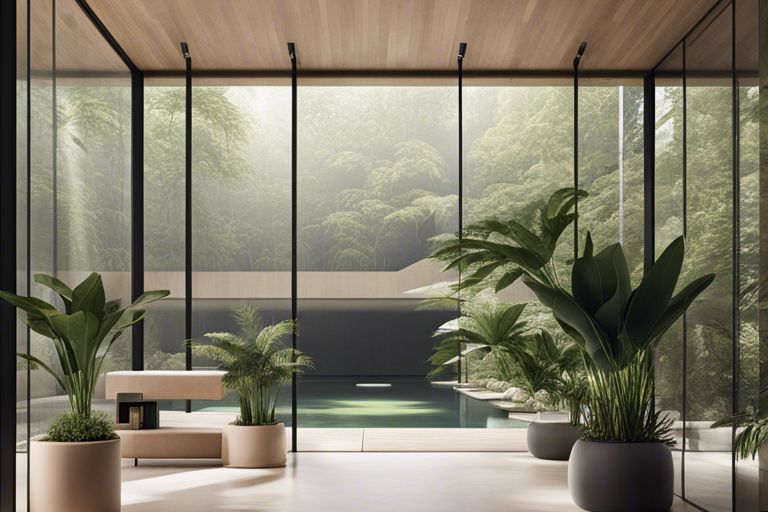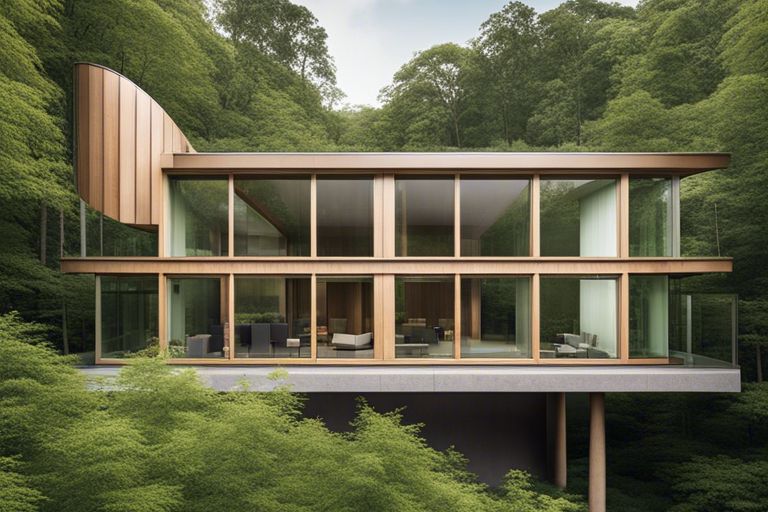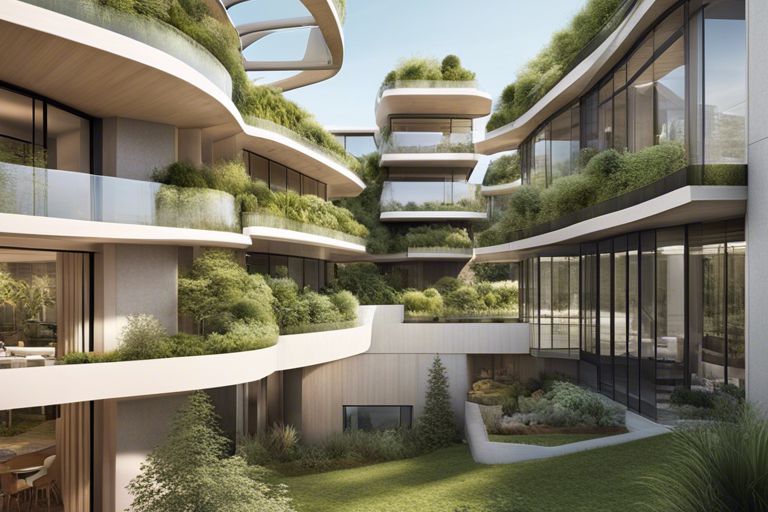Dear reader, in your journey toward creating eco-conscious spaces that harmonize with nature, choosing environmentally-friendly materials is crucial. Dive into the world of biophilic design and discover how incorporating sustainable elements can not only enhance your living or working environment aesthetically but also contribute positively to the health of the planet. Let’s explore the benefits of using eco-friendly materials in your design endeavors.

Key Takeaways:
- Choose Sustainable Materials: Opt for eco-friendly materials such as reclaimed wood, bamboo, cork, or recycled glass to promote a healthier environment.
- Embrace Natural Elements: Incorporate elements like natural light, greenery, and water features into your design to create a connection with nature and improve well-being.
- Reduce Environmental Impact: By using sustainable materials and biophilic design principles, you can lower your carbon footprint and contribute to a more sustainable future for our planet.
Defining Biophilic Design
The Concept of Biophilia
To truly understand biophilic design, you must first grasp the concept of biophilia – the innate human connection to nature. Biophilic design aims to incorporate this natural affinity into the built environment, bringing the outdoors inside to create spaces that promote well-being and harmony.
Principles of Biophilic Design
When delving into the principles of biophilic design, you will discover a set of guidelines that can help you infuse your living or working space with the essence of nature. These principles consist of incorporating natural elements, providing a connection to natural systems, and creating spaces that evoke the feeling of being in nature.
This deliberate inclusion of nature in design has been shown to enhance productivity, reduce stress, and improve overall health and well-being. By implementing these principles, you can create spaces that not only look beautiful but also foster a deep sense of connection to the natural world.
The Importance of Sustainable Materials
Clearly, the materials used in biophilic design play a crucial role in the sustainability of the environment. By opting for sustainable materials, you can significantly reduce the negative impact on the planet and promote a healthier ecosystem.
Environmental Impact of Traditional Materials
Any biophilic design project using traditional materials such as non-recycled plastics, concrete, or metals can have detrimental effects on the environment. These materials often require extensive mining, manufacturing processes, and transportation, leading to high levels of carbon emissions and pollution. Additionally, they contribute to the depletion of natural resources and can take hundreds of years to decompose, further worsening the environmental impact.
Benefits of Eco-Friendly Materials in Biophilic Design
Designing with eco-friendly materials, on the other hand, offers numerous benefits for both you and the environment. These materials are typically sourced sustainably, using renewable resources that have minimal environmental impact. They are often biodegradable, recyclable, or made from recycled content, reducing waste and conserving energy in production.
Designing sustainably not only supports the environment but also enhances the well-being of the inhabitants. By choosing eco-friendly materials in biophilic design, you create spaces that promote better air quality, decrease exposure to harmful chemicals, and establish a deeper connection to nature. The use of natural elements like wood, bamboo, cork, and organic fabrics can improve indoor air quality, regulate temperature, and create a harmonious atmosphere that benefits both physical and mental health.
Importance
The importance of opting for sustainable materials in biophilic design cannot be overstated. By choosing eco-friendly options,
Eco-Friendly Materials for Biophilic Design
Once again, when designing your biophilic space, it is crucial to consider the materials you use to ensure they align with sustainable practices. Choosing eco-friendly materials not only benefits the environment but also contributes to creating a healthier and more harmonious indoor environment.
Natural Materials: Wood, Stone, and Plants
Designing with natural materials such as wood, stone, and plants can enhance the biophilic elements in your space. Wood adds warmth and a natural aesthetic, while stone provides durability and a sense of grounding. Integrating live plants into your design not only improves air quality but also connects you with nature. Incorporating these elements into your space can create a soothing and rejuvenating environment that mimics the outdoors.
Recycled and Repurposed Materials
To reduce environmental impact, consider incorporating recycled and repurposed materials into your biophilic design. Using recycled materials such as reclaimed wood or repurposed furniture not only adds character to your space but also reduces waste. By giving new life to old materials, you contribute to a more sustainable design approach.
Materials that have been repurposed or upcycled can add a unique touch to your biophilic design while reducing the need for new resource extraction.
Low-VOC and Sustainable Paints
Biophilic design extends to the choice of paints you use in your space. Opting for low-VOC (Volatile Organic Compound) and sustainable paints is necessary to maintaining indoor air quality while minimizing environmental impact. These paints have lower levels of harmful emissions, making them safer for you and the environment.
For instance, choosing paints that are Green Seal certified or have a Cradle to Cradle certification ensures that you are selecting products that meet stringent environmental standards.
Designing with Nature in Mind
After embracing the concept of biophilic design, you can enhance your space by incorporating elements that connect you with nature. Maximizing Natural Light and Ventilation is one of the key ways to achieve this.
One
way to do this is by strategically placing windows, skylights, and glass doors to allow natural light to flood into your space. This not only reduces the need for artificial lighting but also helps regulate your circadian rhythms, improving your overall well-being. Additionally, incorporating operable windows and ventilation systems can help bring fresh air into your space, creating a healthier environment for you to thrive in.
Incorporating Water Features and Green Walls
With biophilic design, you can bring the calming effects of nature indoors with the incorporation of water features and green walls. Water features such as indoor fountains or aquariums can add a soothing ambiance to your space, while green walls filled with plants not only improve air quality but also provide a sense of tranquility. Nature has a way of reducing stress and promoting relaxation, making these elements important in your biophilic design.
Using Biometric Principles in Design
Any biophilic design should also consider using biometric principles to create a space that resonates with you on a deeper level. This involves incorporating shapes, patterns, and materials that are inherently familiar to your senses, evoking a sense of comfort and security. By utilizing textures like wood, stone, or water, you can establish a connection with your surroundings, fostering a sense of calm and belonging.
To truly design with nature in mind, you must consider all aspects of biophilic design, from maximizing natural light and ventilation to incorporating water features, green walls, and biometric principles. By intentionally bringing elements of nature into your space, you can create a harmonious environment that promotes well-being and sustainability.
Sustainable Practices in Biophilic Design
All Biophilic Design and Sustainable Building: Achieving a … efficient design efforts start with reducing waste and minimizing your carbon footprint. By carefully sourcing materials, recycling, and reusing when possible, you can make a significant impact on the environment while creating a healthier space for yourself and others.
Reducing Waste and Minimizing Carbon Footprint
Waste management is a critical aspect of sustainable biophilic design. By choosing materials that are sustainably sourced, durable, and recyclable, you can minimize the amount of waste generated during construction and throughout the lifecycle of the building. Incorporating recycling programs and repurposing materials whenever possible can further reduce your carbon footprint and environmental impact.
Implementing Energy-Efficient Systems
The next step in sustainable biophilic design is implementing energy-efficient systems. This includes using renewable energy sources such as solar panels, optimizing natural lighting and ventilation, and investing in energy-efficient appliances and fixtures. By reducing your energy consumption, you can lower your carbon emissions and create a more sustainable living or working environment.
Promoting Biodiversity and Ecosystem Services
Services provided by ecosystems are crucial for our well-being, and promoting biodiversity through biophilic design can help support these services. By incorporating green roofs, vertical gardens, and natural landscaping, you can create habitats for local wildlife, improve air and water quality, and enhance the overall ecosystem resilience. Embracing Biophilic principles not only benefits the environment but also creates a healthier and more harmonious space for everyone who interacts with it.
Challenges and Opportunities in Sustainable Biophilic Design
Overcoming Budget Constraints and Material Limitations
One of the challenges in sustainable biophilic design is overcoming budget constraints and material limitations. However, there are opportunities to explore cost-effective alternatives and eco-friendly materials that can help you achieve your design goals without compromising on sustainability.
Collaborating with Clients and Stakeholders
Any successful sustainable biophilic design project involves collaborating with clients and stakeholders. Engaging with them early on allows for a better understanding of their needs and expectations, which can lead to innovative solutions that benefit both the environment and the end users.
For instance, involving clients and stakeholders in the design process can help foster a sense of ownership and pride in the project, leading to greater support and long-term sustainability of the design.
Staying Up-to-Date with Emerging Trends and Technologies
Staying up-to-date with emerging trends and technologies is crucial in sustainable biophilic design. By keeping abreast of the latest advancements in green building materials and sustainable practices, you can incorporate cutting-edge solutions that enhance the overall environmental performance of your projects.
A commitment to ongoing education and research will ensure that you are at the forefront of sustainable design practices, enabling you to deliver innovative and environmentally friendly solutions to your clients.
Conclusion
Conclusively, incorporating eco-friendly materials in biophilic design is an impactful way to create sustainable and healthy living spaces. By choosing natural, renewable, and non-toxic materials for your projects, you can reduce the environmental impact of construction and improve the health and well-being of occupants. Remember that every sustainable step you take towards using eco-friendly materials contributes to a greener, cleaner future for our planet.
FAQ
Q: What is biophilic design?
A: Biophilic design is an innovative approach that incorporates elements of nature into the built environment to create spaces that enhance our health, well-being, and connection to the natural world.
Q: How can eco-friendly materials be used in biophilic design?
A: Eco-friendly materials such as reclaimed wood, bamboo, cork, and recycled glass can be used in biophilic design to reduce environmental impact, promote sustainability, and create healthier indoor spaces.
Q: What are some sustainable steps to take in biophilic design projects?
A: Some sustainable steps to take in biophilic design projects include selecting materials with low VOC emissions, maximizing natural light and ventilation, incorporating plants and green walls, and choosing products that have minimal impact on the environment throughout their lifecycle.



